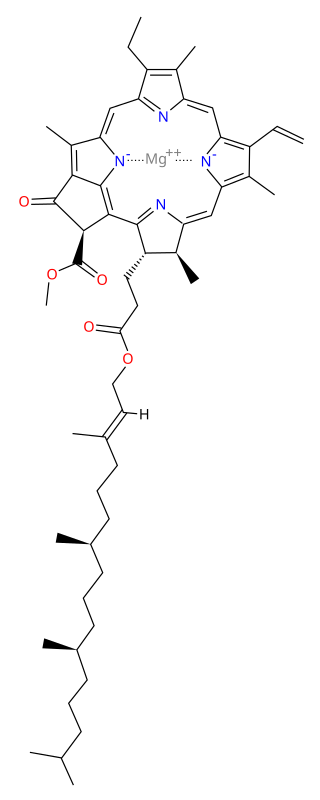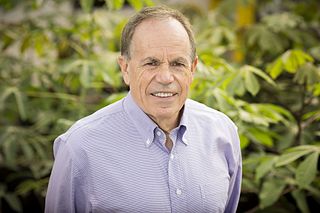
Chlorophyll is any of several related green pigments found in cyanobacteria and in the chloroplasts of algae and plants. Its name is derived from the Greek words χλωρός, khloros and φύλλον, phyllon ("leaf"). Chlorophyll allows plants to absorb energy from light.

Photosynthesis is a system of biological processes by which photosynthetic organisms, such as most plants, algae, and cyanobacteria, convert light energy, typically from sunlight, into the chemical energy necessary to fuel their activities. Photosynthetic organisms use intracellular organic compounds to store the chemical energy they produce in photosynthesis within organic compounds like sugars, glycogen, cellulose and starches. Photosynthesis is usually used to refer to oxygenic photosynthesis, a process that produces oxygen. To use this stored chemical energy, the organisms' cells metabolize the organic compounds through another process called cellular respiration. Photosynthesis plays a critical role in producing and maintaining the oxygen content of the Earth's atmosphere, and it supplies most of the biological energy necessary for complex life on Earth.

Photosystems are functional and structural units of protein complexes involved in photosynthesis. Together they carry out the primary photochemistry of photosynthesis: the absorption of light and the transfer of energy and electrons. Photosystems are found in the thylakoid membranes of plants, algae, and cyanobacteria. These membranes are located inside the chloroplasts of plants and algae, and in the cytoplasmic membrane of photosynthetic bacteria. There are two kinds of photosystems: PSI and PSII.

Photosystem II is the first protein complex in the light-dependent reactions of oxygenic photosynthesis. It is located in the thylakoid membrane of plants, algae, and cyanobacteria. Within the photosystem, enzymes capture photons of light to energize electrons that are then transferred through a variety of coenzymes and cofactors to reduce plastoquinone to plastoquinol. The energized electrons are replaced by oxidizing water to form hydrogen ions and molecular oxygen.

Photosystem I is one of two photosystems in the photosynthetic light reactions of algae, plants, and cyanobacteria. Photosystem I is an integral membrane protein complex that uses light energy to catalyze the transfer of electrons across the thylakoid membrane from plastocyanin to ferredoxin. Ultimately, the electrons that are transferred by Photosystem I are used to produce the moderate-energy hydrogen carrier NADPH. The photon energy absorbed by Photosystem I also produces a proton-motive force that is used to generate ATP. PSI is composed of more than 110 cofactors, significantly more than Photosystem II.

Chlorophyll a is a specific form of chlorophyll used in oxygenic photosynthesis. It absorbs most energy from wavelengths of violet-blue and orange-red light, and it is a poor absorber of green and near-green portions of the spectrum. Chlorophyll does not reflect light but chlorophyll-containing tissues appear green because green light is diffusively reflected by structures like cell walls. This photosynthetic pigment is essential for photosynthesis in eukaryotes, cyanobacteria and prochlorophytes because of its role as primary electron donor in the electron transport chain. Chlorophyll a also transfers resonance energy in the antenna complex, ending in the reaction center where specific chlorophylls P680 and P700 are located.
Far-red light is a range of light at the extreme red end of the visible spectrum, just before infrared light. Usually regarded as the region between 700 and 750 nm wavelength, it is dimly visible to human eyes. It is largely reflected or transmitted by plants because of the absorbance spectrum of chlorophyll, and it is perceived by the plant photoreceptor phytochrome. However, some organisms can use it as a source of energy in photosynthesis. Far-red light also is used for vision by certain organisms such as some species of deep-sea fishes and mantis shrimp.

Eugene Rabinowitch was a Russian-born American biophysicist who is known for his work in photosynthesis and nuclear energy. He was a co-author of the Franck Report and a co-founder in 1945 of the Bulletin of the Atomic Scientists, a global security and public policy magazine, which he edited until his death.

A photosynthetic reaction center is a complex of several proteins, pigments, and other co-factors that together execute the primary energy conversion reactions of photosynthesis. Molecular excitations, either originating directly from sunlight or transferred as excitation energy via light-harvesting antenna systems, give rise to electron transfer reactions along the path of a series of protein-bound co-factors. These co-factors are light-absorbing molecules (also named chromophores or pigments) such as chlorophyll and pheophytin, as well as quinones. The energy of the photon is used to excite an electron of a pigment. The free energy created is then used, via a chain of nearby electron acceptors, for a transfer of hydrogen atoms (as protons and electrons) from H2O or hydrogen sulfide towards carbon dioxide, eventually producing glucose. These electron transfer steps ultimately result in the conversion of the energy of photons to chemical energy.
The photosynthetic efficiency is the fraction of light energy converted into chemical energy during photosynthesis in green plants and algae. Photosynthesis can be described by the simplified chemical reaction
In biophysics, the Kautsky effect is a phenomenon consisting of a typical variation in the behavior of a plant fluorescence when exposed to light. It was discovered in 1931 by H. Kautsky and A. Hirsch.

Photoinhibition is light-induced reduction in the photosynthetic capacity of a plant, alga, or cyanobacterium. Photosystem II (PSII) is more sensitive to light than the rest of the photosynthetic machinery, and most researchers define the term as light-induced damage to PSII. In living organisms, photoinhibited PSII centres are continuously repaired via degradation and synthesis of the D1 protein of the photosynthetic reaction center of PSII. Photoinhibition is also used in a wider sense, as dynamic photoinhibition, to describe all reactions that decrease the efficiency of photosynthesis when plants are exposed to light.

Light-dependent reactions are certain photochemical reactions involved in photosynthesis, the main process by which plants acquire energy. There are two light dependent reactions: the first occurs at photosystem II (PSII) and the second occurs at photosystem I (PSI).
The Emerson effect is the increase in the rate of photosynthesis after chloroplasts are exposed to light of wavelength 680 nm and more than 680 nm. When simultaneously exposed to light of both wavelengths, the rate of photosynthesis is far higher than the sum of the red light and far red light photosynthesis rates. The effect was early evidence that two photosystems, processing different wavelengths, cooperate in photosynthesis.

Chlorophyll fluorescence is light re-emitted by chlorophyll molecules during return from excited to non-excited states. It is used as an indicator of photosynthetic energy conversion in plants, algae and bacteria. Excited chlorophyll dissipates the absorbed light energy by driving photosynthesis, as heat in non-photochemical quenching or by emission as fluorescence radiation. As these processes are complementary processes, the analysis of chlorophyll fluorescence is an important tool in plant research with a wide spectrum of applications.

Plant stress measurement is the quantification of environmental effects on plant health. When plants are subjected to less than ideal growing conditions, they are considered to be under stress. Stress factors can affect growth, survival and crop yields. Plant stress research looks at the response of plants to limitations and excesses of the main abiotic factors, and of other stress factors that are important in particular situations. Plant stress measurement usually focuses on taking measurements from living plants. It can involve visual assessments of plant vitality, however, more recently the focus has moved to the use of instruments and protocols that reveal the response of particular processes within the plant

Robert Emerson was an American scientist noted for his discovery that plants have two distinct photosynthetic reaction centres.
Prafullachandra Vishnu Sane is an Indian molecular biologist and plant physiologist, known for his pioneering studies on photosynthesis. He is a former director of National Botanical Research Institute and an elected fellow of the Indian Academy of Sciences, Indian National Science Academy, National Academy of Sciences, India, National Academy of Agricultural Sciences and the Maharashtra Academy of Sciences. The Council of Scientific and Industrial Research, the apex agency of the Government of India for scientific research, awarded him the Shanti Swarup Bhatnagar Prize for Science and Technology, one of the highest Indian science awards, in 1981, for his contributions to biological sciences.

Stephen Patrick Long is a British-born American environmental plant physiologist and member of the National Academy of Sciences studying how to improve photosynthesis to increase the yield of food and biofuel crops. He is the Stanley O. Ikenberry Chair Professor of Plant Biology and Crop Sciences at the University of Illinois and Distinguished Professor in Crop Sciences at Lancaster University. His work, published in Science, proved that photosynthesis can be manipulated to increase plant productivity—an idea once considered the holy grail of plant biology. Long has added to our understanding of the long-term impacts of climate change, such as rising levels of carbon dioxide and ozone on plants. He has briefed former President George W. Bush and the Vatican, as well as Bill Gates and Anne, Princess Royal, on food security and bioenergy.

Photoautotrophs are organisms that can utilize light energy from sunlight and elements from inorganic compounds to produce organic materials needed to sustain their own metabolism. This biological activity is known as photosynthesis, and examples of such photosynthetic organisms include plants, algae and cyanobacteria.












